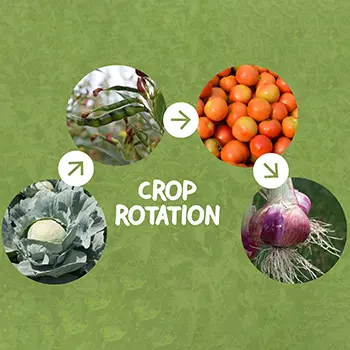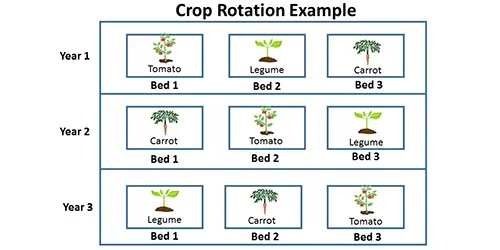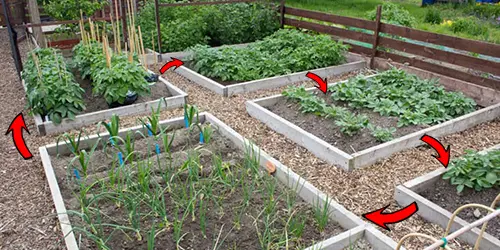Crop rotation is a critical part of the gardening process. Some homesteaders assume it’s for farmers and so rarely engage in it. But the evidence suggests it’s the best thing you can do for your garden, and that it’s even more beneficial for homesteaders because of the variety of plants you grow each year. Crop rotation is basically rotating the crops you’ve planted on the same piece of land to improve and maintain soil health. It may seem like a time-consuming and tedious practice to rotate your crops, but it’s extremely important. Crop rotation assists in moving away from the process of continuous mono-cropping or monoculture which is where the same crops are planted in the same plot year after year. The process of mono-cropping depletes the soil of nutrients and stunts plant growth. If you’ve done everything to improve the health of your crops, and they’re still not growing the way they should, you might want to try crop rotation. Keep reading to find out everything you need to know about crop rotation.
The Benefits of Crop Rotation
There are several benefits associated with crop rotation including the following:
Reduces Disease and Insects: Similar plants typically have the same pathogens, and so crop rotation disrupts the habitat and cycle of pests.
Improved Nitrogen Levels: Plants can’t absorb nitrogen from the air, they need it from the soil either in the form of nitrite, nitrate, or ammonia. One way the soil gets nitrogen is through the roots of legumes such as lentils, peas, and soybeans. When legumes are planted together, they increase nitrogen levels.
Improved Soil Structure: Crops need healthy soil to grow, poor soil structure will cause an unhealthy root system in plants. Unhealthy roots lead to several problems such as the inability to absorb nutrients, crop erosion, and surface runoff. Nevertheless, a strong soil structure increases water retention, increases soil porosity, and improves nutrient absorption.
Prevents Soil Erosion: Soil erosion has become a global issue; heavy erosion causes problems such as the increased risk of flooding, toxic agricultural runoff, and the loss of topsoil. The good news is that crop rotation is an effective preventative measure.
Related: How to Adjust the pH in Soil and Water for Abundant Harvests
More Crops: The main aim of growing crops is to ensure you have enough to eat and sell. So the more crops you grow, the better it is for you. All the benefits mentioned providing the perfect environment for healthy crop growth. Several studies have discovered that crop rotation increases harvest. One study conducted by Washington State University found that crop rotation yielded between eleven to fifty-eight percent more crops.
Healthy Living Environment: Considering the fact that over 200,000 people per year die from pesticide poisoning, and approximately two million pesticide-related health conditions are reported annually, it should be considered a national health crisis. An estimated two billion kilograms of pesticides are applied to crops each year, and only 0.1 percent of them cover the pests. The remaining 99.9 percent of these harmful fumes are released into the atmosphere which causes health problems for both humans and animals. As mentioned, crop rotation limits pests which means it reduces the need for applying pesticides to crops.
The Disadvantages of Crop Rotation
The advantages definitely outweigh the disadvantages of crop rotation; nevertheless, it’s important to mention them. Here are a few disadvantages you might want to take into consideration:
- The initial investment is expensive
- You need to educate yourself significantly about the practice before getting started
- Unexpected weather conditions can destroy sensitive plants
- If you don’t live in a farming area, you will have limited access to information about crop rotation
The Best Way to Rotate Your Crops
The best way to rotate your crops is to divide your growing space into several areas. Decide which crops you want to grow and then keep plants from the same family in one area. Change the location of the plants yearly to give the plants the advantage of new ground.

Grow brassicas after legumes because legumes fix nitrogen into the soil, and brassicas benefit from this. Potatoes also benefit from nitrogen-rich soil. However, don’t plant them next to brassicas because they thrive at different pH levels.
Roots don’t do well in very rich soil; therefore, refrain from planting root vegetables in heavily fertilized soil. Plant parsnips in soil that have that kept demanding crops such as brassicas the following season because they break down the rich elements of the soil.
Tips For Crop Rotation
As mentioned, there are plenty of benefits associated with crop rotation. However, if you want to get the most out of crop rotation, there are some practical tips you’ll need to follow:
Stick to Family Groupings
To ensure your crop rotation is a success, keep all major family groups together. Here are the main ones:
- Alliums: Garlic, leeks, shallots, onions.
- Legumes: Soybeans, peanuts, southern peas, green peas, green beans.
- Brassicas: Collards, mustard greens, Chinese cabbage, radishes, turnip greens, Brussels sprouts, kale, cabbage, cauliflower, broccoli.
- Nightshades: Potatoes, peppers, eggplant, tomatoes.
- Umbellifers: Dill, parsley, fennel, parsnips, carrots.
- Cucurbits: Gourds, cantaloupe, watermelons, winter squash, pumpkins, cukes, summer squash, zucchini.
It’s also important to mention that there are a few exceptions when it comes to crop rotation. Herbs and perennial vegetables shouldn’t be moved because they remain in the ground all year round. For example, asparagus needs to settle in one spot for a few years before it’s ready for harvesting. Also, mint is best contained in one bed because of how easily it spreads.

Record Keeping
Crop rotation is a relatively simple practice, but it can get confusing; therefore, it’s advised you have a system in place to keep track of everything. Keeping a written record, or using an online tool will help keep you organized.
Keep a Written Record: Draw a rough sketch of your garden and write down the location of your plants by plant family. If you keep varieties, write out a list of their names too.
Use an Online Tool: An online tool will simplify the process even further. Instead of keeping written records about your planting history over the years, the vegetable garden planner will do everything for you. You can try it out free of charge for seven days to see if it’s a good fit for you. If you like it, you pay $40 for the year. I think that’s a bargain considering all the time you’ll save because it can take hours to keep written records in order.
Final Thought
Have you heard the saying, “prevention is better than cure?” Crop rotation will significantly reduce the number of issues you have with your garden. Although it’s another job to add to your already long to-do list, it will save you a lot of time and money in the future.
You may also like:
A Medicinal Plant MAP That Should Be In Your Survival Kit (Video)
21 Gardening Items You Should Get From the Dollar Store
How You Can Find Out If Your Homestead Water Is Polluted Or Clean















